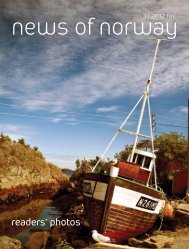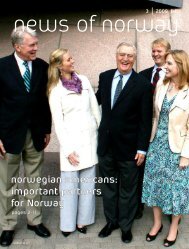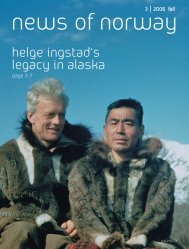Create successful ePaper yourself
Turn your PDF publications into a flip-book with our unique Google optimized e-Paper software.
film issue<br />
dear reader,<br />
Even though <strong>Norway</strong> has had its own<br />
film industry since the silent movie era,<br />
with few exceptions – such as when<br />
“Kon-Tiki” won an Oscar in 1951 – it catered<br />
mostly to a domestic audience. Traditionally,<br />
Norwegians <strong>of</strong>ten have preferred foreign<br />
movies, especially those made in Hollywood.<br />
Norwegian filmmakers<br />
worked in<br />
the shadow <strong>of</strong><br />
Sweden through<br />
the 1960s and ‘70s<br />
with names such as<br />
Ingmar Bergman<br />
in the spotlight,<br />
and in the 1980s, it<br />
was Danish film,<br />
with Lars von Trier<br />
and his “dogma”<br />
concept movies<br />
and his disciples,<br />
that won international<br />
acclaim.<br />
However, there has<br />
long been an international awareness <strong>of</strong><br />
Scandinavian filmmaking and its unique perspective<br />
on the human condition.<br />
The good news is that in the last 15 years<br />
we have seen a remarkable surge <strong>of</strong><br />
Norwegian films, reflecting contemporary<br />
life and human challenges. Many <strong>of</strong> these<br />
films have received awards at major film festivals<br />
in Europe and North America. There are<br />
some key explanations to why we now see a<br />
vibrant and internationally recognized<br />
Norwegian movie industry. Firstly, we need<br />
PHOTO BY ARILD STRØMMEN<br />
to go back to the 1980s, when commercial TV<br />
arrived in <strong>Norway</strong>. With it came new job<br />
opportunities for filmmakers to make TV<br />
commercials for the domestic and international<br />
markets. A lot <strong>of</strong> creativity was released,<br />
and Norwegian commercials became cool and<br />
won major prizes abroad with their particular<br />
brand <strong>of</strong> humorous storytelling.<br />
Young and unknown filmmakers gained<br />
the confidence they needed to move to short<br />
films and feature movies. Secondly, the establishment<br />
<strong>of</strong> the Lillehammer Film Academy<br />
increased interest in filmmaking and laid the<br />
foundation for a larger and more pr<strong>of</strong>essional<br />
filmmaking community. Finally, the government<br />
made the strategic decision to substantially<br />
increase long-term funding <strong>of</strong><br />
Norwegian film production. Since then, the<br />
cultural policy has been to fund many film<br />
projects, both the small and independent films<br />
in addition to the more commercial ones.<br />
Today, we are reaping the fruits <strong>of</strong> this<br />
investment. As someone involved in public<br />
diplomacy, I cannot think <strong>of</strong> many other<br />
forms <strong>of</strong> communication that so effectively<br />
can tell a story about my country and help<br />
place it not only in people’s minds, but also in<br />
their hearts. You can read more about<br />
Norwegian films and actors in this issue <strong>of</strong><br />
<strong>News</strong> <strong>of</strong> <strong>Norway</strong>. Many <strong>of</strong> the Norwegian<br />
movies presented here are available at better<br />
stocked DVD stores around the United States,<br />
are sold on the internet, and are frequently<br />
screened at film festivals and independent<br />
movie theaters in larger cities. Do take the<br />
time to see some <strong>of</strong> them!<br />
jannicke jaeger, counselor <strong>of</strong> communications,<br />
royal norwegian embassy<br />
Royal Norwegian Embassy<br />
2720 34th. St., NW<br />
Washington, D.C. 20008<br />
(202) 333-6000<br />
www.norway.org<br />
AMBASSADOR<br />
Wegger Chr. Strommen<br />
COUNSELOR, COMMUNICATIONS<br />
Jannicke Jaeger<br />
EDITOR<br />
Arild Strommen<br />
EDITORIAL ASSISTANT<br />
Eli Havn<br />
SUBSCRIPTION<br />
<strong>News</strong> <strong>of</strong> <strong>Norway</strong> (ISSN: 0028-9272)<br />
is published by the Royal Norwegian<br />
Embassy in Washington, D.C. The<br />
magazine was founded in 1941 and<br />
reaches 37,000 subscribers in the United<br />
States and Canada. For a free subscription,<br />
write or call with your name and<br />
address, or send an email to<br />
subscription@norway.org<br />
Norwegian<br />
film through<br />
100 years<br />
by ingerid lund & eli havn<br />
1906/1908:<br />
The first film produced in<br />
<strong>Norway</strong> has been lost and<br />
source material is ambiguous.<br />
Produced by Hugo Hermansen in<br />
1906 or 1908, it was entitled<br />
"Dangers <strong>of</strong> a Fisherman's Life"<br />
("Fiskerlivets farer") or "A Drama<br />
at Sea" ("Et drama paa havet").<br />
1931:<br />
<strong>Norway</strong>'s first movie with<br />
sound, "The Big Christening," is<br />
released, written by Tancred<br />
Ibsen, grandson <strong>of</strong> authors<br />
Henrik Ibsen and Bjørnstjerne<br />
Bjørnson. The 30s were a time<br />
<strong>of</strong> growth and heightened popularity<br />
for the film industry.<br />
2 | news <strong>of</strong> norway | spring 2009<br />
PHOTOS IN TIMELINE COURTESY OF NORWEGIAN FILM INSTITUTE












